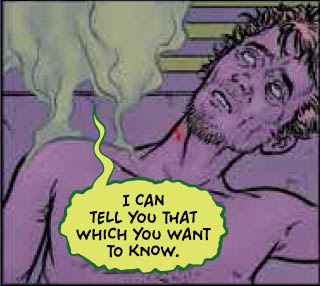 |
| Shadowman #3 Cover B by Tyler Kirkham |
Warning: This post most definitely contains spoilers. Read ahead at your own risk!
Sometimes storytellers tell their stories out of sequence. They start at what they consider the crucial bit--the moment of extreme tension--then use flashbacks to give you insight into what is currently happening. Writer Tim Seeley often used this approach to great effect in his Bloodshot series.
I'd like to say the story structure writer Cullen Bunn used for Shadowman #3 worked well. Unfortunately, I just don't understand the motivating events that brought Shadowman first to Haiti, and from there to Barcelona.
People practice Voodoo all over the world. Voodoo is a religion we particularly associate with Shadowman's hometown of New Orleans. There must be Voodoo leaders of real knowledge and importance who reside in New Orleans. So did Shadowman really need to go to Haiti?
Or was it merely to remind readers of the events in Cullen Bunn's earlier Punk Mambo miniseries?
Barcelona is a city with a long history. It offers some terrific visuals for a Shadowman adventure. Writer Cullen Bunn provides readers with a historical essay on Barcelona in the Shadowman #3 Pre-Order edition that gives us an insight into the city's storied past. If you purchased another cover, I would recommend that you still seek out the Pre-Order edition so you can read the essay.
Still. It made sense that the events in Shadowman #1 took place in Jack Boniface's backyard. The idea of a ghost town being haunted worked well in Shadowman #2. But why Haiti and Barcelona in Shadowman #3?
If something in Cullen's essay informed the current story, or suggested why the settings of Haiti and Barcelona are integral to the events that take place in Shadowman #3, I missed it.
Most important to me is this: what exactly happened in Haiti? What precisely drew the attention of the villain of this issue, the person who sent the loa to attack Shadowman? At the time, it's clear that something heavy duty is about to go down. Even Baron Samedi appears to have reservations about going through with the whole deal.
It's important to know a protagonist's intentions in such motivating events. Sadly, writer Cullen Bunn skims over this. Jon Davis-Hunt's artwork, which normally signals so much, doesn't make this clear. We're left to guess what exactly happens in this room, when a man dies.
Did Shadowman intend for the man to die? Isn't it his job to protect this man?
Isn't this man's life worth more than any secrets Shadowman might learn?
Perhaps a later issue will answer these questions. But I dislike not knowing how I should regard my heroes in the issue I'm currently reading. In Shadowman #3, did Shadowman, to coin a phrase, Do a Deal with the Devil?
Is this another case of a Valiant hero becoming a cold-blooded murderer (albeit to protect others), as in the series Bloodshot Salvation?
I don't know what to think. Do you?
Dragon Dave






No comments:
Post a Comment